LAB REPORT
Science and Technology Making Headlines
June 29, 2018

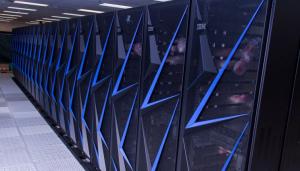
Lawrence Livermore’s newest supercomputer, Sierra, with a peak performance of 125 petaFLOPS (quadrillion floating-point operations per second), ranked third fastest in the world on the latest TOP500 list.
US reaches the summit
Lawrence Livermore nabbed the third spot on the Top500 list of the world’s fastest supercomputers.
For the first time since November 2012, the fastest computer in the world is a U.S. machine, known as Summit that lives at Oak Ridge National Laboratory with a sustained theoretical performance of 122.3 petaflops on the High Performance Linpack test used to rank the Top500 list.
The No. 3 system also is new, the Sierra machine at Lawrence Livermore, which delivered 71.6 petaflops on HPL. Built by IBM, Sierra's architecture is quite similar to that of Summit, with each of its 4,320 nodes powered by two Power9 CPUs plus four Nvidia Tesla V100 GPUs and using the same Mellanox EDR InfiniBand as the system interconnect.
Summit and Sierra are both part of the Department of Energy’s program known as Collaboration of Oak Ridge, Argonne, and Lawrence Livermore national labs (CORAL), which is aimed at accelerating the development of high-performance computing and speeding the way toward exascale computing.

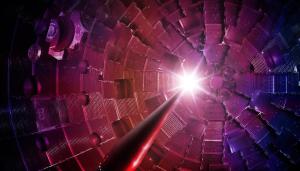
This rendering of the inside of NIF’s target chamber shows the target positioner moving into place.
Warp speed ahead
Nearly a decade has passed since director J.J. Abrams delivered his hugely anticipated reboot of the Star Trek movie series. The 2009 film, titled simply “Star Trek,” was a massive commercial success and it introduced a new generation to the crew of the Starship Enterprise.
But how does the real science behind the movie hold up?
The Star Trek franchise is particularly well-respected in the scientific community for getting its facts straight relative to the demands of Hollywood entertainment and speculative fiction. Apart from the hard physics of space travel and energy weapons, Tammy Ma, an experimental physicist at Lawrence Livermore National Laboratory, works with the most powerful lasers on the planet at her lab in the National Ignition Facility. The lasers operate at temperatures hotter than the sun’s core. Happily, for everyone involved, these temperature flashes are extremely tiny and extremely brief.
Several scenes from the film’s sequel, "Into Darkness," were filmed at the National Ignition Facility.
“Our target chamber, where we do all our experiments, that was actually the warp core for the Starship Enterprise,” Ma said.

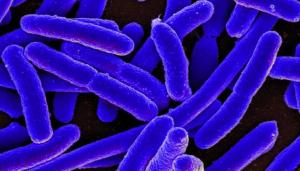
Scanning electron micrograph of Mycobacterium tuberculosis, the bacteria that cause tuberculosis.
Peering into tuberculosis bacteria
An international team of researchers including those from Lawrence Livermore has found a new way to investigate how tuberculosis bacteria inactivates an important family of antibiotics: They watched the process in action for the first time using an X-ray free-electron laser.
Tuberculosis (Tb), a lung disease that spreads in the air through coughs or sneezes, kills more people worldwide than any other infectious agent, according to the World Health Organization’s latest global report. In hundreds of thousands of cases each year, treatment fails because the bacteria that cause Tb have become resistant to antibiotics.
The researchers observed how an enzyme from drug-resistant Tb bacteria damages an antibiotic molecule. The new technique provides a powerful tool to examine changes in biological molecules as they happen.
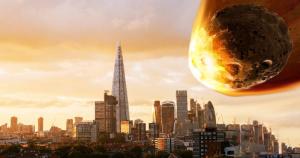
Asteroid Bennu, which is larger than the Empire State Building, could one day slam into Earth.
Watch out for that asteroid
Scientists are worried since there’s a chance -- albeit only 1 in 2,700, according to current calculations -- that an asteroid taller than the Empire State Building and 1,664 times as heavy as the Titanic will hit the Earth Sept. 25, 2135.
If it does, it’s estimated that the kinetic energy of the impact would be equivalent to 1,200 megatons -- 80,000 times the energy of the atomic bomb dropped on Hiroshima.
“The chance of an impact appears slim now, but the consequences would be dire,” said Kirsten Howley, a physicist at Lawrence Livermore.
Lawrence Livermore scientists are part of a “national planetary defense team, including NASA, the National Nuclear Security Administration and Los Alamos National Laboratory, that has designed a conceptual spacecraft to deflect Earth-bound asteroids. The team has evaluated whether it would be able to knock Bennu -- the massive asteroid that could strike in 2135 -- off its course.

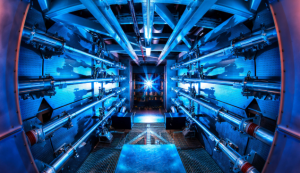
Laser preamplifiers at the National Ignition Facility. Photo by Damien Jemison/LLNL.
An energizing milestone
Physicists working at the National Ignition Facility say they have passed another important milestone in their quest for nuclear fusion energy. They have shown that the fusion energy generated by the laser implosion of a deuterium-tritium fuel capsule is twice that of the kinetic energy of the implosion. By further trebling the fusion energy, they say they will be close to the long-sought goal of an overall net energy gain.
The NIF trains 192 pulsed laser beams on to the inner surface of a centimeter-long hollow metal cylinder known as a hohlraum. Inside is a fuel capsule, which is a roughly 2 millimeter-diameter hollow sphere containing a thin deuterium-tritium layer. Each pulse lasts just a few nanoseconds and the lasers can deliver about 1.8 megajoules of energy. This powerful blast causes the capsule to implode rapidly, creating immense temperatures and pressures inside a central “hot spot,” where fusion reactions occur.
The long-term goal is that the energy of neutrons given off by fusion can generate electricity. Before this is possible, NIF must show that it is possible to achieve ignition -- the point at which fusion reactions generate at least as much energy delivered by the laser system. This involves self-sustaining reactions, in which the alpha particles that are also emitted during fusion give off enough heat to initiate further fusion.


Lab Report takes a break
The Lab Report will take a break for the Fourth of July holiday. It will return July 13.





